氯化钴安全技术说明书英文
氧化钴-安全技术说明书MSDS

第一部分化学品及企业标识化学品中文名:氧化钴化学品英文名:Cobalt oxideCAS No.:1307-96-6分子式:CoO产品推荐及限制用途:工业及科研用途。
第二部分危险性概述紧急情况概述吞咽有害。
可能导致皮肤过敏反应。
对水生生物毒性极大并具有长期持续影响。
GHS危险性类别急性经口毒性类别 4皮肤致敏物类别 1危害水生环境——急性危险类别 1危害水生环境——长期危险类别 1标签要素:象形图:警示词:警告危险性说明:H302 吞咽有害H317 可能导致皮肤过敏反应H410 对水生生物毒性极大并具有长期持续影响防范说明●预防措施:—— P264 作业后彻底清洗。
—— P270 使用本产品时不要进食、饮水或吸烟。
—— P261 避免吸入粉尘/烟/气体/烟雾/蒸气/喷雾。
—— P272 受沾染的工作服不得带出工作场地。
—— P280 戴防护手套/穿防护服/戴防护眼罩/戴防护面具。
—— P273 避免释放到环境中。
●事故响应:—— P301+P312 如误吞咽:如感觉不适,呼叫解毒中心/ 医生—— P330 漱口。
—— P302+P352 如皮肤沾染:用水充分清洗。
—— P333+P313 如发生皮肤刺激或皮疹:求医/就诊。
—— P362+P364 脱掉沾染的衣服,清洗后方可重新使用—— P391 收集溢出物。
●安全储存:—— P403+P233 存放在通风良好的地方。
保持容器密闭。
—— P405 存放处须加锁。
●废弃处置:—— P501 按当地法规处置内装物/容器。
物理和化学危险:无资料。
健康危害:吞咽有害。
可能导致皮肤过敏反应。
环境危害:对水生生物毒性极大并具有长期持续影响。
第三部分成分/组成信息√物质混合物第四部分急救措施急救:吸入:如果吸入,请将患者移到新鲜空气处。
皮肤接触:脱去污染的衣着,用肥皂水和清水彻底冲洗皮肤。
如有不适感,就医。
眼晴接触:分开眼睑,用流动清水或生理盐水冲洗。
如有不适感,就医。
氯化钴化学品安全技术说明书

氯化钴化学品安全技术说明书
第一部分:化学品名称
化学品中文名称:氯化钴
化学品英文名称: cobalt chloride
中文名称2:
英文名称2:
技术说明书编码: 1625
CAS No.: 7791-13-1
分子式: CoCl2.6H2O
分子量: 237.93
第二部分:成分/组成信息
有害物成分含量 CAS No.
氯化钴 7791-13-1
第三部分:危险性概述
危险性类别:
侵入途径:
健康危害:吸入本品粉尘对呼吸道有刺激性。
长期吸入引起严重肺疾患。
对敏感个体,吸入本品粉尘可致肺部阻塞性病变,出现气短等症状。
粉尘对眼有刺激性,长期接触可致眼损害。
对皮肤有致敏性,可致皮炎。
摄入引起恶心、呕吐、腹泻;大量摄入引起急性中毒,引起血液、甲状腺和胰脏损害。
环境危害:
燃爆危险:本品不燃,有毒,具刺激性,具致敏性。
第四部分:急救措施
皮肤接触:脱去污染的衣着,用大量流动清水冲洗。
眼睛接触:立即提起眼睑,用大量流动清水或生理盐水彻底冲洗至少15分钟。
就医。
吸入:脱离现场至空气新鲜处。
如呼吸困难,给输氧。
就医。
食入:饮足量温水,催吐。
洗胃,导泄。
就医。
第五部分:消防措施。
化学品安全技术说明书 英文
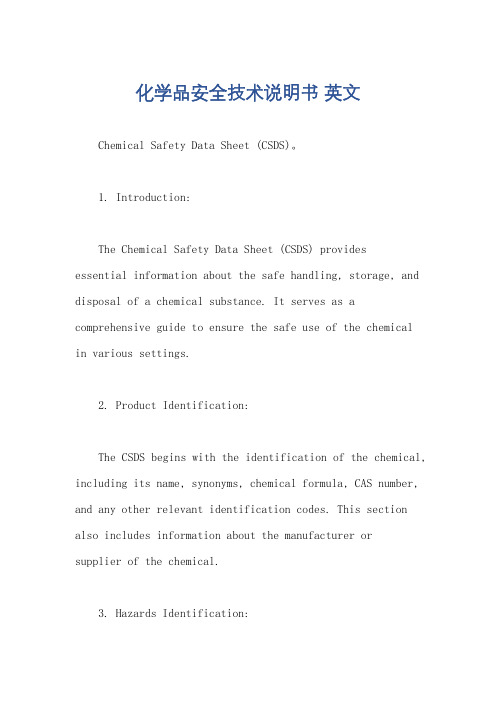
化学品安全技术说明书英文Chemical Safety Data Sheet (CSDS)。
1. Introduction:The Chemical Safety Data Sheet (CSDS) providesessential information about the safe handling, storage, and disposal of a chemical substance. It serves as a comprehensive guide to ensure the safe use of the chemicalin various settings.2. Product Identification:The CSDS begins with the identification of the chemical, including its name, synonyms, chemical formula, CAS number, and any other relevant identification codes. This section also includes information about the manufacturer orsupplier of the chemical.3. Hazards Identification:In this section, the potential hazards associated with the chemical are described. It includes information about the physical, health, and environmental hazards, such as flammability, toxicity, reactivity, and ecological impact. The CSDS also provides information on the potential routes of exposure and symptoms of exposure.4. Composition/Information on Ingredients:This section provides details about the chemical composition of the substance, including the percentage of each ingredient. It may also include information about impurities or additives that may contribute to the hazards.5. First Aid Measures:The CSDS outlines the recommended first aid procedures to be followed in case of accidental exposure or ingestion of the chemical. It provides instructions on the immediate actions to take, such as rinsing eyes or skin, seeking medical attention, and providing necessary information tohealthcare professionals.6. Firefighting Measures:This section provides guidance on how to handle fires involving the chemical. It includes information on suitable extinguishing methods, fire-fighting equipment, and any specific precautions to be taken to minimize the risks associated with the chemical during a fire.7. Accidental Release Measures:The CSDS provides instructions on how to respond to accidental releases or spills of the chemical. It includes recommendations on containment, cleanup procedures, and appropriate personal protective equipment (PPE) to be used during the cleanup.8. Handling and Storage:This section provides guidelines on the safe handling, storage, and transportation of the chemical. It includesinformation on recommended storage conditions, incompatible substances, and precautions to prevent accidents or exposure.9. Exposure Controls/Personal Protection:The CSDS outlines the recommended exposure limits forthe chemical and provides guidance on implementing appropriate control measures to minimize exposure. This may include engineering controls, such as ventilation systems, as well as personal protective equipment (PPE) requirements.10. Physical and Chemical Properties:This section provides information about the physicaland chemical properties of the chemical, such as appearance, odor, melting point, boiling point, solubility, and stability. It also includes information on pH, viscosity, and any other relevant properties.11. Toxicological Information:The CSDS provides information on the potential health effects of the chemical, including acute and chronic toxicity, routes of exposure, and target organs. It may also include information on carcinogenicity, mutagenicity, and reproductive toxicity.12. Ecological Information:This section provides information on the environmental impact of the chemical, including its potential effects on aquatic organisms, soil, and air. It may also include information on bioaccumulation and persistence in the environment.13. Disposal Considerations:The CSDS provides guidance on the proper disposal methods for the chemical, including any specific regulations or requirements that need to be followed. It may include information on recycling options, treatment methods, or disposal through authorized facilities.14. Transport Information:This section provides information on the safe transportation of the chemical, including any regulations or requirements that need to be followed during transportation. It may include information on packaging, labeling, and any special precautions to be taken.15. Regulatory Information:The CSDS includes information on relevant regulations and legal requirements governing the use, handling, and disposal of the chemical. It may include information on international, national, or local regulations that need to be complied with.16. Other Information:This section may include additional information that is not covered in the previous sections, such as references, revision history, and contact details of the manufacturer or supplier for further inquiries.Please note that the content and format of a Chemical Safety Data Sheet may vary depending on the country or regulatory requirements. The above information provides a general overview of what is typically included in an English version of a CSDS.。
完整版)化学品安全技术说明书(MSDS)中英文对照及翻译完整版

完整版)化学品安全技术说明书(MSDS)中英文对照及翻译完整版剔除格式错误和明显有问题的段落,改写如下:XX公司XX nMaterial Safety Data ___化学品安全技术说明书SECTION 1: ___化学品及企业标识PRODUCT NAME:产品名CAS NO.:SUPPLIER:供应商:___:企业应急SECTION 2: HAZARDS ___危险性概述2.1 CLASSIFICATION OF ___物质分类This substance is ___(EC) No 1272/2008.根据(EC) No 1272/2008规定此物质不属于危险品。
2.2 LABEL ELEMENTS标记要素The product does not require special ___.此产品不需要按照___法则或各国法规进行特殊标签。
2.3 OTHER HAZARDS – NONE其他危害n ___: drug abuse侵入途径:误服___ HAZARDS健康危害Eye contact: May cause eye ___。
redness。
___.眼接触:可引起眼睛刺激、发红、流泪、视力模糊。
Skin contact: May cause skin ___ contact may cause skin degrease.皮肤接触:可引起皮肤刺激和皮炎。
长时间接触可能导致皮肤脱脂。
Refer to ns 7.8 and 13 for further n on handling。
___ of the product。
Always follow ___ necessary。
6.1 Personal ns。
______ dust and avoid inhaling vapours。
mist or gas。
___ 8.6.2 Environmental nsIf safe to do so。
take ___。
氯化钴化学品安全技术说明书

氯化钴化学品安全技术说明书
氯化钴化学品安全技术说明书
第一部分:化学品名称
化学品中文名称:氯化钴
化学品英文名称: cobalt chloride
中文名称2:
英文名称2:
技术说明书编码: 1625
CAS No.: 7791-13-1
分子式: CoCl2.6H2O
分子量: 237.93
第二部分:成分/组成信息
有害物成分含量 CAS No.
氯化钴 7791-13-1
第三部分:危险性概述
危险性类别:
侵入途径:
健康危害:吸入本品粉尘对呼吸道有刺激性。
长期吸入引起严重肺疾患。
对敏感个体,吸入本品粉尘可致肺部阻塞性病变,出现气短等症状。
粉尘对眼有刺激性,长期接触可致眼损害。
对皮肤有致敏性,可致皮炎。
摄入引起恶心、呕吐、腹泻;大量摄入引起急性中毒,引起血液、甲状腺和胰脏损害。
环境危害:
燃爆危险:本品不燃,有毒,具刺激性,具致敏性。
第四部分:急救措施
皮肤接触:脱去污染的衣着,用大量流动清水冲洗。
眼睛接触:立即提起眼睑,用大量流动清水或生理盐水彻底冲洗至少15分钟。
就医。
吸入:脱离现场至空气新鲜处。
如呼吸困难,给输氧。
就医。
食入:饮足量温水,催吐。
洗胃,导泄。
就医。
第五部分:消防措施。
上海易恩化学技术有限公司-氯化钴安全技术说明书

化学品安全技术说明书公司地址:上海化学工业区奉贤分区银工路28号E栋楼客服热线:400-133-2688 1 化学品及企业标识1.1 产品标识符化学品俗名或商品名:氯化钴CAS No.:7791-13-1别名:氯化钴,六水;六水合氯化钴;氯化;氯化钴,六水合物;六水氯化钴;1.2 鉴别的其他方法无数据资料1.3 有关的确定了的物质或混合物的用途和建议不适合的用途无数据资料2 危险性概述2.1 GHS分类健康危害急性毒性(经口):AcuteTox.4急性毒性(经皮):AcuteTox.4严重损伤/刺激眼睛:EyeDam.1皮肤腐蚀/刺激:SkinCorr.1B生殖细胞敏感性:Muta.2致癌性:Carc.1B生殖毒性:Repr.1A环境危害急性水生毒性:AquaticAcute12.2 GHS 标记要素,包括预防性的陈述危害类型GHS07:感叹号; GHS08:健康危害;信号词 【危险】危险申明H302 如果吞食有害健康。
H313 皮肤接触可能对健康不利。
H314 引起严重的皮肤灼伤,以及眼睛损伤。
H317 可能会导致皮肤过敏反应。
H334 吸入可能引起过敏或哮喘症状或呼吸困难。
H350 可能会导致癌症。
H360 可能会损坏生育能力或损坏。
H400 对水生生物非常有毒。
代码 无数据资料警告申明P201 使用前获得特别指示说明。
P261 避免吸入粉尘/烟/气体/烟雾/蒸汽/喷雾。
P273 避免释放到环境中。
P280 戴防护手套/防护服/护眼/防护面具。
P305+P351+P338 如进入眼睛:用水小心清洗几分钟。
如果可以做到,摘掉隐形眼镜,继续冲洗。
P310 立即呼叫解毒中心/医生。
RSHazard symbol(s) T;NR-phrase(s) R22;R49;R43;R53S-phrase(s) S22;S45;S53;S612.3 其它危害物-无3 成分/组成信息3.1 物质分子式 - Cl2CoH12O6分子量 - 237.934 急救措施4.1 必要的急救措施描述一般的建议无数据资料如果吸入提供新鲜空气.如有需要,提供人工呼吸。
氯化镍安全技术说明书英文
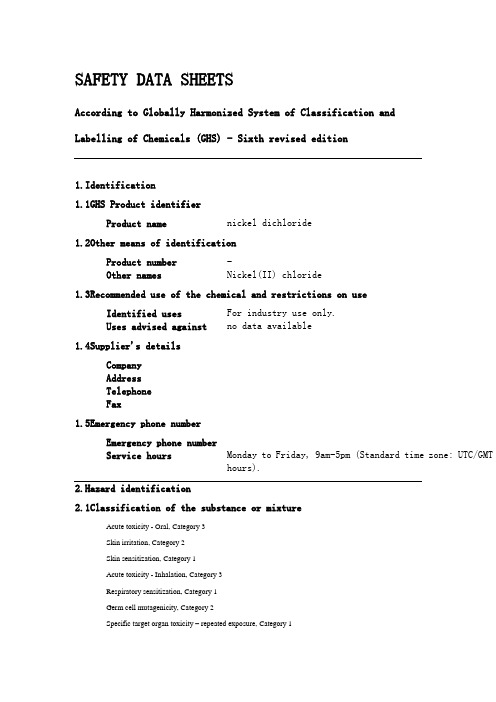
SAFETY DATA SHEETSAccording to Globally Harmonized System of Classification andLabelling of Chemicals (GHS) - Sixth revised edition1.Identification1.1GHS Product identifierProduct name nickel dichloride1.2Other means of identificationProduct number-Other names Nickel(II) chloride1.3Recommended use of the chemical and restrictions on useIdentified uses For industry use only.Uses advised against no data available1.4Supplier's detailsCompanyAddressTelephoneFax1.5Emergency phone numberEmergency phone numberService hours Monday to Friday, 9am-5pm (Standard time zone: UTC/GMThours).2.1Classification of the substance or mixtureAcute toxicity - Oral, Category 3Skin irritation, Category 2Skin sensitization, Category 1Acute toxicity - Inhalation, Category 3Respiratory sensitization, Category 1Germ cell mutagenicity, Category 2Specific target organ toxicity – repeated exposure, Category 1Hazardous to the aquatic environment, short-term (Acute) - Category Acute 1Hazardous to the aquatic environment, long-term (Chronic) - Category Chronic 1Carcinogenicity, Category 1AReproductive toxicity, Category 1B2.2GHS label elements, including precautionary statementsPictogram(s)Signal word DangerHazard statement(s)H301 Toxic if swallowedH315 Causes skin irritationH317 May cause an allergic skin reactionH331 Toxic if inhaledH334 May cause allergy or asthma symptoms or breathingdifficulties if inhaledH341 Suspected of causing genetic defectsH410 Very toxic to aquatic life with long lasting effectsH350iPrecautionarystatement(s)Prevention P264 Wash ... thoroughly after handling.P270 Do not eat, drink or smoke when using this product.P280 Wear protective gloves/protective clothing/eyeprotection/face protection.P261 Avoid breathing dust/fume/gas/mist/vapours/spray.P272 Contaminated work clothing should not be allowed out of theworkplace.P271 Use only outdoors or in a well-ventilated area.P284 [In case of inadequate ventilation] wear respiratory protection.P201 Obtain special instructions before use.P202 Do not handle until all safety precautions have been read andunderstood.P260 Do not breathe dust/fume/gas/mist/vapours/spray.P273 Avoid release to the environment.Response P301+P310 IF SWALLOWED: Immediately call a POISONCENTER/doctor/…P321 Specific treatment (see ... on this label).P330 Rinse mouth.P302+P352 IF ON SKIN: Wash with plenty of water/...P332+P313 If skin irritation occurs: Get medical advice/attention.P362+P364 Take off contaminated clothing and wash it before reuse.P333+P313 If skin irritation or rash occurs: Get medicaladvice/attention.P304+P340 IF INHALED: Remove person to fresh air and keepcomfortable for breathing.P311 Call a POISON CENTER/doctor/…P342+P311 If experiencing respiratory symptoms: Call a POISONCENTER/doctor/...P308+P313 IF exposed or concerned: Get medical advice/ attention.P314 Get medical advice/attention if you feel unwell.P391 Collect spillage.Storage P405 Store locked up.P403+P233 Store in a well-ventilated place. Keep container tightlyclosed.Disposal P501 Dispose of contents/container to ...2.3Other hazards which do not result in classificationnone3.1Substances4.1Description of necessary first-aid measuresGeneral adviceConsult a physician. Show this safety data sheet to the doctor in attendance.If inhaledIf breathed in, move person into fresh air. If not breathing, give artificial respiration. Consult aphysician.In case of skin contactWash off with soap and plenty of water. Consult a physician.In case of eye contactRinse thoroughly with plenty of water for at least 15 minutes and consult a physician.If swallowedNever give anything by mouth to an unconscious person. Rinse mouth with water. Consult aphysician.4.2Most important symptoms/effects, acute and delayedno data available4.3Indication of immediate medical attention and special treatment needed, if necessaryno data available5.1Extinguishing mediaSuitable extinguishing mediaUse water spray, alcohol-resistant foam, dry chemical or carbon dioxide.5.2Specific hazards arising from the chemicalno data available5.3Special protective actions for fire-fightersWear self-contained breathing apparatus for firefighting if necessary.6.1Personal precautions, protective equipment and emergency proceduresUse personal protective equipment. Avoid dust formation. Avoid breathing vapours, mist or gas.Ensure adequate ventilation. Evacuate personnel to safe areas. Avoid breathing dust. Forpersonal protection see section 8.6.2Environmental precautionsPrevent further leakage or spillage if safe to do so. Do not let product enter drains. Dischargeinto the environment must be avoided.6.3Methods and materials for containment and cleaning upPick up and arrange disposal. Sweep up and shovel. Keep in suitable, closed containers fordisposal.7.1Precautions for safe handlingAvoid contact with skin and eyes. Avoid formation of dust and aerosols. Avoid exposure -obtain special instructions before use.Provide appropriate exhaust ventilation at places wheredust is formed. For precautions see section 2.2.7.2Conditions for safe storage, including any incompatibilitiesStore in cool place. Keep container tightly closed in a dry and well-ventilated place.8.1Control parametersOccupational Exposure limit valuesno data availableBiological limit valuesno data available8.2Appropriate engineering controlsHandle in accordance with good industrial hygiene and safety practice. Wash hands beforebreaks and at the end of workday.8.3Individual protection measures, such as personal protectiveequipment (PPE)Eye/face protectionSafety glasses with side-shields conforming to EN166. Use equipment for eye protection testedand approved under appropriate government standards such as NIOSH (US) or EN 166(EU).Skin protectionWear impervious clothing. The type of protective equipment must be selected according to theconcentration and amount of the dangerous substance at the specific workplace. Handle withgloves. Gloves must be inspected prior to use. Use proper glove removal technique(withouttouching glove's outer surface) to avoid skin contact with this product. Dispose of contaminatedgloves after use in accordance with applicable laws and good laboratory practices. Wash anddry hands. The selected protective gloves have to satisfy the specifications of EU Directive89/686/EEC and the standard EN 374 derived from it.Respiratory protectionWear dust mask when handling large quantities.Thermal hazardsno data availablePhysical state orange powderColour no data available Odour no data available339°C(lit.)Melting point/ freezingpoint291°C(lit.)Boiling point or initialboiling point and boilingrangeFlammability no data availableno data available Lower and upper explosionlimit / flammabilitylimitFlash point43°C(lit.)no data availableAuto-ignitiontemperatureDecompositionno data available temperaturepH no data available Kinematic viscosity no data available Solubility no data availableno data available Partition coefficientn-octanol/water (logvalue)Vapour pressure no data available Density and/or relative3.55g/mLat 25°C(lit.) densityRelative vapour density no data available Particle characteristics n o data available10.1Reactivityno data available10.2Chemical stabilityStable under recommended storage conditions.10.3Possibility of hazardous reactionsno data available10.4Conditions to avoidno data available10.5Incompatible materialsno data available10.6Hazardous decomposition productsno data availableAcute toxicity•Oral: no data available•Inhalation: no data available•Dermal: no data availableSkin corrosion/irritationno data availableSerious eye damage/irritationno data availableRespiratory or skin sensitizationno data availableGerm cell mutagenicityno data availableCarcinogenicityno data availableReproductive toxicityno data availableSTOT-single exposureno data availableSTOT-repeated exposureno data availableAspiration hazardno data available12.1Toxicity•Toxicity to fish: no data available•Toxicity to daphnia and other aquatic invertebrates: no data available •Toxicity to algae: no data available•Toxicity to microorganisms: no data available12.2Persistence and degradability12.3Bioaccumulative potentialno data available12.4Mobility in soilno data available12.5Other adverse effectsno data available13.1Disposal methodsProductThe material can be disposed of by removal to a licensed chemical destruction plant or bycontrolled incineration with flue gas scrubbing. Do not contaminate water, foodstuffs, feed orseed by storage or disposal. Do not discharge to sewer systems.Contaminated packagingContainers can be triply rinsed (or equivalent) and offered for recycling or reconditioning.Alternatively, the packaging can be punctured to make it unusable for other purposes and thenbe disposed of in a sanitary landfill. Controlled incineration with flue gas scrubbing is possiblefor combustible packaging materials.14.1UN NumberADR/RID: UN3288IMDG: UN3288IATA: UN3288 14.2UN Proper Shipping NameADR/RID: TOXIC SOLID, INORGANIC, N.O.S.IMDG: TOXIC SOLID, INORGANIC, N.O.S.IATA: TOXIC SOLID, INORGANIC, N.O.S.14.3Transport hazard class(es)ADR/RID: 9IMDG: 9IATA: 9 14.4Packing group, if applicableADR/RID: III IMDG: III IATA: III 14.5Environmental hazardsADR/RID: yes IMDG: yes IATA: yes 14.6Special precautions for user14.7Transport in bulk according to Annex II of MARPOL 73/78 and the IBC Codeno data available15.1Safety, health and environmental regulations specific for the product in questionInformation on revisionCreation Date Aug 12, 2017Revision Date Aug 12, 2017Abbreviations and acronyms•CAS: Chemical Abstracts Service•ADR: European Agreement concerning the International Carriage of Dangerous Goods by Road •RID: Regulation concerning the International Carriage of Dangerous Goods by Rail•IMDG: International Maritime Dangerous Goods•IATA: International Air Transportation Association•TWA: Time Weighted Average•STEL: Short term exposure limit•LC50: Lethal Concentration 50%•LD50: Lethal Dose 50%•EC50: Effective Concentration 50%Disclaimer: The above information is believed to be correct but does not purportto be all inclusive and shall be used only as a guide. The information in this documentis based on the present state of our knowledge and is applicable to the product withregard to appropriate safety precautions. It does not represent any guarantee ofthe properties of the product. We as supplier shall not be held liable for any damage resulting from handling or from contact with the above product.。
化学品安全技术说明书MSDS中英文对照及翻译
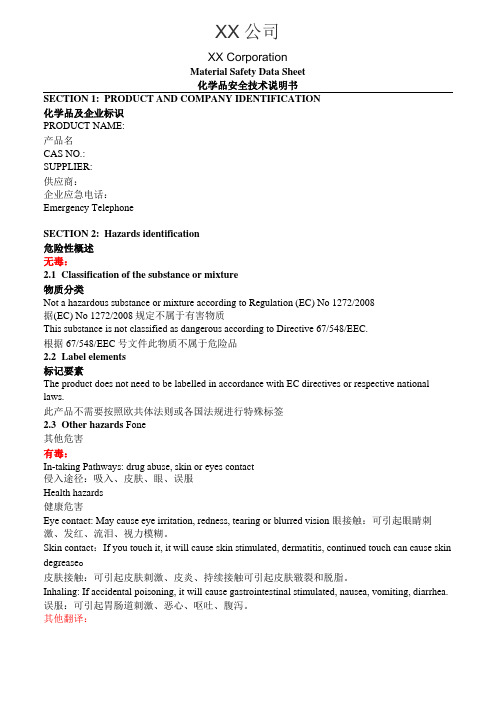
XX公司XX CorporationMaterial Safety Data Sheet化学品安全技术说明书SECTION 1:PRODUCT AND COMPANY IDENTIFICATION化学品及企业标识PRODUCT NAME:产品名CAS NO.:SUPPLIER:供应商:企业应急电话:Emergency TelephoneSECTION 2:Hazards identification危险性概述无毒:2.1Classification of the substance or mixture物质分类Not a hazardous substance or mixture according to Regulation (EC) No 1272/2008据(EC) No 1272/2008规定不属于有害物质This substance is not classified as dangerous according to Directive 67/548/EEC.根据67/548/EEC号文件此物质不属于危险品2.2Label elements标记要素The product does not need to be labelled in accordance with EC directives or respective national laws.此产品不需要按照欧共体法则或各国法规进行特殊标签2.3Other hazards Fone其他危害有毒:In-taking Pathways: drug abuse, skin or eyes contact侵入途径:吸入、皮肤、眼、误服Health hazards健康危害Eye contact: May cause eye irritation, redness, tearing or blurred vision 眼接触:可引起眼睛刺激、发红、流泪、视力模糊。
化学品安全技术说明书MSDS中英文对照翻译
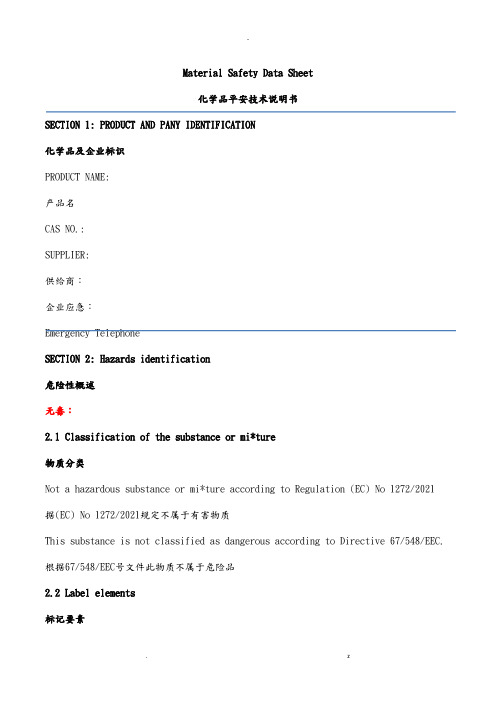
Material Safety Data Sheet化学品平安技术说明书SECTION 1: PRODUCT AND PANY IDENTIFICATION化学品及企业标识PRODUCT NAME:产品名CAS NO.:SUPPLIER:供给商:企业应急:Emergency TelephoneSECTION 2: Hazards identification危险性概述无毒:2.1 Classification of the substance or mi*ture物质分类Not a hazardous substance or mi*ture according to Regulation (EC) No 1272/2021 据(EC) No 1272/2021规定不属于有害物质This substance is not classified as dangerous according to Directive 67/548/EEC. 根据67/548/EEC号文件此物质不属于危险品2.2 Label elements标记要素The product does not need to be labelled in accordance with EC directives or respective national laws.此产品不需要按照欧共体法则或各国法规进展特殊标签2.3 Other hazards – none其他危害有毒:In-taking Pathways: drug abuse, skin or eyes contact侵入途径:吸入、皮肤、眼、误服Health hazards安康危害Eye contact: May cause eye irritation, redness, tearing or blurred vision眼接触:可引起眼睛刺激、发红、流泪、视力模糊。
Skincontact:If you touch it, it will cause skin stimulated, dermatitis, continued touch can cause skin degrease。
新版MSDS——二氯化钴

该物质对环境有危害,应特别注意对水体的污染。 第十三部分:废弃处置
ቤተ መጻሕፍቲ ባይዱ
无资料。 起运时包装要完整,装载应稳妥。运输过程中要确保容器不泄漏、不倒塌、 不坠落、不损坏。严禁与氧化剂、活性金属、活性金属、食用化学品等混装 混运。运输途中应防曝晒、雨淋,防高温。车辆运输完毕应进行彻底清扫。 公路运输时要按规定路线行驶。 第十五部分:法规信息 化学危险物品安全管理条例 (1987年2月17日国务院发布),化学危险物品安 全管理条例实施细则 (化劳发[1992] 677号),工作场所安全使用化学品规 定 ([1996]劳部发423号)等法规,针对化学危险品的安全使用、生产、储存 、运输、装卸等方面均作了相应规定。 第十六部分:其他信息 无
二氯化钴
TLVWN: 监测方法: 工程控制: 呼吸系统防护: 眼睛防护: 身体防护: 手防护: 其他防护: 未制定标准 火焰原子吸收光谱法;催化极谱法 密闭操作,局部排风。 空气中粉尘浓度超标时,必须佩戴自吸过滤式防尘口罩。紧急事态抢救或撤 离时,应该佩戴空气呼吸器。 戴化学安全防护眼镜。 穿防毒物渗透工作服。 戴橡胶手套。 工作场所禁止吸烟、进食和饮水,饭前要洗手。工作完毕,淋浴更衣。保持 良好的卫生习惯。 第九部分:理化特性 蓝色叶片状结晶粉末,具有吸湿性。
危险特性: 有害燃烧产物: 灭火方法:
应急处理:
操作注意事项:
储存注意事项:
储存于阴凉、通风的库房。远离火种、热源。防止阳光直射。包装密封。应 与氧化剂、碱金属、食用化学品分开存放,切忌混储。储区应备有合适的材 料收容泄漏物。 第八部分:接触控制和个人防护措施 未制定标准 未制定标准 未制定标准
中国MAC(mg/m3): 前苏联MAC(mg/m3): TLVTN:
化学品安全技术说明范本ENGLISH
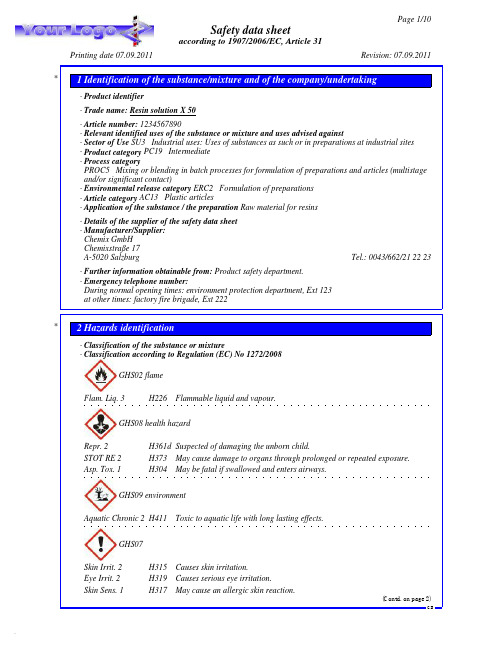
Page 1/10Safety data sheetaccording to 1907/2006/EC, Article 31Printing date 07.09.2011Revision: 07.09.2011Classification according to Regulation (EC) No 1272/2008Trade name:Resin solution X 50(Contd. of page 1) STOT SE 3H336May cause drowsiness or dizziness.· Classification according to Directive 67/548/EEC or Directive 1999/45/ECXn; HarmfulR48/20-63:Harmful: danger of serious damage to health by prolonged exposure through inhalation.Possible risk of harm to the unborn child.Xi; IrritantR36/38:Irritating to eyes and skin.Xi; SensitisingR43:May cause sensitisation by skin contact.N; Dangerous for the environmentR51/53:Toxic to aquatic organisms, may cause long-term adverse effects in the aquaticenvironment.R67:Vapours may cause drowsiness and dizziness.· Information concerning particular hazards for human and environment:The product has to be labelled due to the calculation procedure of the "General Classification guideline for preparations of the EU" in the latest valid version.· Classification system:The classification is according to the latest editions of the EU-lists, and extended by company andliterature data.· Label elements· Labelling according to Regulation (EC) No 1272/2008The product is classified and labelled according to the CLP regulation.· Hazard pictogramsGHS02GHS07GHS08GHS09· Signal word Danger· Hazard-determining components of labelling:reaction product: bisphenol-A-(epichlorhydrin) epoxy resin (number average molecular weight ≤ 700) toluene· Hazard statementsH226Flammable liquid and vapour.H315Causes skin irritation.H319Causes serious eye irritation.H317May cause an allergic skin reaction.H361d Suspected of damaging the unborn child.H336May cause drowsiness or dizziness.H373May cause damage to organs through prolonged or repeated exposure.H304May be fatal if swallowed and enters airways.H411Toxic to aquatic life with long lasting effects.Contains epoxy constituents. May produce an allergic reaction.(Contd. on page 3)GBTrade name:Resin solution X 50(Contd. of page 2)· Precautionary statementsP101If medical advice is needed, have product container or label at hand.P102Keep out of reach of children.P103Read label before use.P210Keep away from heat/sparks/open flames/hot surfaces. - No smoking.P301+P310IF SWALLOWED: Immediately call a POISON CENTER or doctor/physician.P303+P361+P353IF ON SKIN (or hair): Remove/Take off immediately all contaminated clothing.Rinse skin with water/shower.P305+P351+P338IF IN EYES: Rinse cautiously with water for several minutes. Remove contact lenses, if present and easy to do. Continue rinsing.P405Store locked up.P501Dispose of contents/container in accordance with local/regional/national/international regulations.· Other hazards· Results of PBT and vPvB assessment· PBT:Not applicable.· vPvB:Not applicable.≤Xi R36/38; N R51/53Aquatic Chronic 2, H411; Skin Irrit. 2, H315; Eye Irrit. 2,H319; Skin Sens. 1, H317F R11Repr. Cat. 3Flam. Liq. 2, H225; Repr. 2, H361d; STOT RE 2, H373; Asp.Tox. 1, H304; Skin Irrit. 2, H315; STOT SE 3, H336R66-67Flam. Liq. 2, H225; Eye Irrit. 2, H319; STOT SE 3, H336butanolR10-67Flam. Liq. 3, H226; Eye Irrit. 2, H319; STOT SE 3,H335+H336R67Flam. Liq. 2, H225; Eye Irrit. 2, H319; STOT SE 3, H336Trade name:Resin solution X 50(Contd. of page 3)· Additional information:For the wording of the listed risk phrases refer to section 16.(Contd. on page 5)Trade name:Resin solution X 50(Contd. of page 4)Trade name:Resin solution X 50(Contd. of page 5)· Protection of hands:Protective glovesThe glove material has to be impermeable and resistant to the product/ the substance/ the preparation.Due to missing tests no recommendation to the glove material can be given for the product/ thepreparation/ the chemical mixture.Selection of the glove material on consideration of the penetration times, rates of diffusion and thedegradation· Material of glovesThe selection of the suitable gloves does not only depend on the material, but also on further marks of quality and varies from manufacturer to manufacturer. As the product is a preparation of severalsubstances, the resistance of the glove material can not be calculated in advance and has therefore to be checked prior to the application.· Penetration time of glove materialThe exact break through time has to be found out by the manufacturer of the protective gloves and has to be observed.· Eye protection:Tightly sealed gogglesTrade name:Resin solution X 50(Contd. of page 6)· Explosion limits:Lower: 1.2 Vol %Upper:11.5 Vol %· Vapour pressure at 20°C:97 hPa· Density:Not determined.· Relative density Not determined.· Vapour density Not determined.· Evaporation rate Not determined.· Solubility in / Miscibility withwater:Not miscible or difficult to mix.· Segregation coefficient (n-octanol/water):Not determined.· Viscosity:Dynamic:Not determined.Kinematic:Not determined.· Solvent content:Organic solvents:50.0 %Solids content:50.0 %· Other information No further relevant information available.Trade name:Resin solution X 50(Contd. of page 7)· Additional toxicological information:The product shows the following dangers according to the calculation method of the General EUClassification Guidelines for Preparations as issued in the latest version:IrritantTrade name:Resin solution X 50(Contd. of page 8)· UN proper shipping name· IMDG, IATA RESIN SOLUTION· Transport hazard class(es)· ADR· Class 3 Flammable liquids.· Label 3· IMDG, IATA· Class 3 Flammable liquids.· Label 3· Packing group· ADR, IMDG, IATA III· Environmental hazards:· Marine pollutant:No· Special marking (ADR):Symbol (fish and tree)· Special precautions for user Warning: Flammable liquids.· Danger code (Kemler):30· EMS Number:F-E,S-E· Transport in bulk according to Annex II ofMARPOL73/78 and the IBC Code Not applicable.· Transport/Additional information:· ADR· Tunnel restriction code D/E· UN "Model Regulation":UN1263; PAINT; 3; IIITrade name:Resin solution X 50(Contd. of page 9) H226Flammable liquid and vapour.H304May be fatal if swallowed and enters airways.H315Causes skin irritation.H317May cause an allergic skin reaction.H319Causes serious eye irritation.H335May cause respiratory irritation.H336May cause drowsiness or dizziness.H361d Suspected of damaging the unborn child.H373May cause damage to organs through prolonged or repeated exposure.H411Toxic to aquatic life with long lasting effects.R10Flammable.R11Highly flammable.R36Irritating to eyes.R36/37Irritating to eyes and respiratory system.R36/38Irritating to eyes and skin.R38Irritating to skin.R43May cause sensitisation by skin contact.R48/20Harmful: danger of serious damage to health by prolonged exposure through inhalation.R51/53Toxic to aquatic organisms, may cause long-term adverse effects in the aquatic environment.R63Possible risk of harm to the unborn child.R65Harmful: may cause lung damage if swallowed.R66Repeated exposure may cause skin dryness or cracking.R67Vapours may cause drowsiness and dizziness.· Department issuing MSDS:Product safety department.· Contact:Dr. Peter Mayer· Abbreviations and acronyms:ADR: Accord européen sur le transport des marchandises dangereuses par Route (European Agreement concerning theInternational Carriage of Dangerous Goods by Road)RID: Règlement international concernant le transport des marchandises dangereuses par chemin de fer (Regulations Concerning the International Transport of Dangerous Goods by Rail)IMDG: International Maritime Code for Dangerous GoodsIATA: International Air Transport AssociationICAO: International Civil Aviation OrganizationGHS: Globally Harmonized System of Classification and Labelling of ChemicalsLC50: Lethal concentration, 50 percentLD50: Lethal dose, 50 percent· * Data compared to the previous version altered.GB。
氯化钴-职业病危害告知牌

职业病危害告知牌对人体有损害,请注意防护!
氯化钴Cobalt dichloride
健康危害理化特性
对眼睛、皮肤和粘膜有刺激作用,长时间或反复
接触可引起过敏反应。
大量接触可抑制红细胞的
产生。
蓝色叶片状结晶粉末,具有吸湿性。
溶于水、
醇、醚、丙酮、吡啶、甘油。
熔点735℃,
沸点1049℃。
职业接触限值:MAC:无资料
PC-TWA:无资料
PC-STEL:无资料
应急处理
皮肤接触:用肥皂水及清水彻底冲洗。
就医。
眼睛接触:拉开眼睑,用流动清水冲洗15分钟。
就医。
吸入:脱离现场至空气新鲜处。
就医。
食入:误服者,饮适量温水,催吐。
洗胃。
就医。
注意防护
密闭操作,全面通风。
操作人员必须经过专门培训,严格遵守操作规程。
建议操作人员佩戴直接式防毒面具,戴化学安全防护眼镜,穿防腐工作服,戴橡胶手套。
防止蒸气泄漏到工作场所空气中。
避免与酸类接触。
搬运时要轻装轻卸,防止包装及容器损坏。
急救电话:120 消防电话:119 职业卫生咨询电话:1031。
化工品各项证书

MSDS (Material Safety Data Sheet)即化学品安全说明书,亦可译为化学品安全技术说明书或化学品安全数据说明书。
是化学品生产商和进口商用来阐明化学品的理化特性(如PH值,闪点,易燃度,反应活性等)以及对使用者的健康(如致癌,致畸等)可能产生的危害的一份文件。
SDS - 概况十二烷基磺酸钠(Sodium dodecyl sulfate,SDS),是洗洁精的主要成分。
常用于DNA提取过程中使蛋白质变性后与DNA分开。
蛋白质是一种复杂的有机大分子的组合,含有碳、氢、氧、氮,通常还有硫,磷。
蛋白质是生命最基本的组成部分之一,是生物化学的主要研究对象之一。
DNA,为英文Deoxyribonucleic aci d的缩写,又称脱氧核糖核酸,是染色体的主要化学成分,同时也是组成基因的材料。
还有一种SDS,叫做十二烷基硫酸钠。
质量标准 Q/(HG)SJ 445-91 项目Item 分析纯化学纯 (AR) (CP) 含量[CH3(CH2)10CH2SO3Na]Assay,%≥ 98.5 97.0 硫酸钠(Na2SO4)Sodium sulfate,% ≤ 2.0 3.0 水分(H2O)Water,% ≤ 0.5 1.0 不皂化物Not saponifiable matter,% ≤ 0.5 1.0 用途REACH 即Regulation (EC) NO 1907/2006 of the European parliament and of the council of 18 December 2006 concerning the Registration, Evaluation, Authorization and Restriction of Chemicals (REACH), establishing a European Chemicals Agency, amending Directive 1999/45/EC and repealing Council Regulation (EEC) No 793/93 andCommission Regulation (EC) No 1488/94 as well as Council Directive 76/769/EEC and Commission Directives 91/155/EEC, 93/67/EEC, 93/105/EC and 2000/21/EC。
(完整版)化学品安全技术说明书大全MSDS
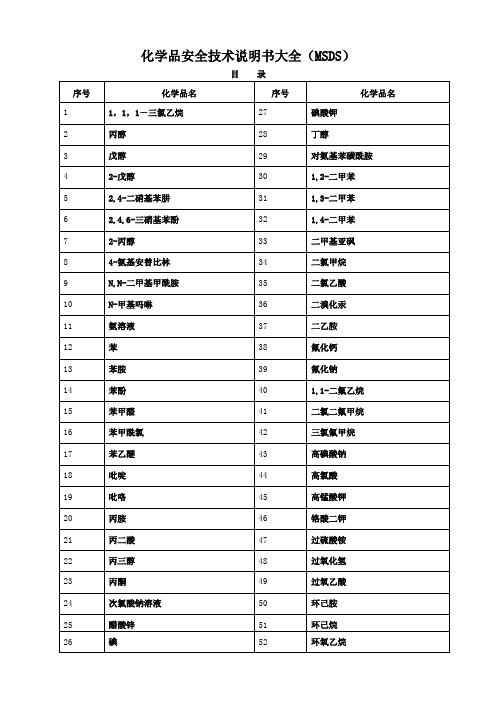
化学品安全技术说明书大全(MSDS)1,1,1-三氯乙烷化学品安全技术说明书第一部分:化学品名称化学品中文名称: 1,1,1-三氯乙烷化学品英文名称: 1,1,1-trichloroethane中文名称2:甲基氯仿英文名称2: methyl chloroform技术说明书编码: 612CAS No.: 71-55-6分子式: C2H3Cl3分子量: 133.42第二部分:成分/组成信息有害物成分含量 CAS No.1,1,1-三氯乙烷≥95.0% 71-55-6第三部分:危险性概述危险性类别:侵入途径:健康危害:急性中毒主要损害中枢神经系统。
轻者表现为头痛、眩晕、步态蹒跚、共济失调、嗜睡等;重者可出现抽搐,甚至昏迷。
可引起心律不齐。
对皮肤有轻度脱脂和刺激作用。
环境危害:燃爆危险:本品可燃,有毒,具刺激性。
-第四部分:急救措施皮肤接触:脱去污染的衣着,用肥皂水和清水彻底冲洗皮肤。
眼睛接触:提起眼睑,用流动清水或生理盐水冲洗。
就医。
吸入:迅速脱离现场至空气新鲜处。
保持呼吸道通畅。
如呼吸困难,给输氧。
如呼吸停止,立即进行人工呼吸。
就医。
食入:饮足量温水,催吐。
就医。
第五部分:消防措施危险特性:遇明火、高热能燃烧,并产生剧毒的光气和氯化氢烟雾。
与碱金属和碱土金属能发生强烈反应。
与活性金属粉末(如镁、铝等)能发生反应, 引起分解。
有害燃烧产物:一氧化碳、二氧化碳、氯化氢、光气。
灭火方法:消防人员须佩戴防毒面具、穿全身消防服,在上风向灭火。
喷水保持火场容器冷却,直至灭火结束。
灭火剂:雾状水、泡沫、二氧化碳、砂土。
第六部分:泄漏应急处理应急处理:迅速撤离泄漏污染区人员至安全区,并进行隔离,严格限制出入。
切断火源。
建议应急处理人员戴自给正压式呼吸器,穿防毒服。
从上风处进入现场。
尽可能切断泄漏源。
防止流入下水道、排洪沟等限制性空间。
小量泄漏:用砂土或其它不燃材料吸附或吸收。
大量泄漏:构筑围堤或挖坑收容。
用泡沫覆盖,降低蒸气灾害。
化学品安全技术说明书MSDS中英文对照翻译完整版

Material Safety Data Sheet化学品安全技术说明书SECTION 1: PRODUCT AND COMPANY IDENTIFICATION化学品及企业标识PRODUCT NAME:产品名CAS NO.:SUPPLIER:供应商:企业应急电话:Emergency TelephoneSECTION 2: Hazards identification危险性概述无毒:2.1 Classification of the substance or mixture物质分类Not a hazardous substance or mixture according to Regulation (EC) No 1272/2008据(EC) No 1272/2008规定不属于有害物质This substance is not classified as dangerous according to Directive 67/548/EEC.根据67/548/EEC号文件此物质不属于危险品2.2 Label elements标记要素The product does not need to be labelled in accordance with EC directives or respective national laws.此产品不需要按照欧共体法则或各国法规进行特殊标签2.3 Other hazards – none其他危害有毒:In-taking Pathways: drug abuse, skin or eyes contact侵入途径:吸入、皮肤、眼、误服Health hazards健康危害Eye contact: May cause eye irritation, redness, tearing or blurred vision眼接触:可引起眼睛刺激、发红、流泪、视力模糊。
化学品安全技术说明书大全(MSDS)
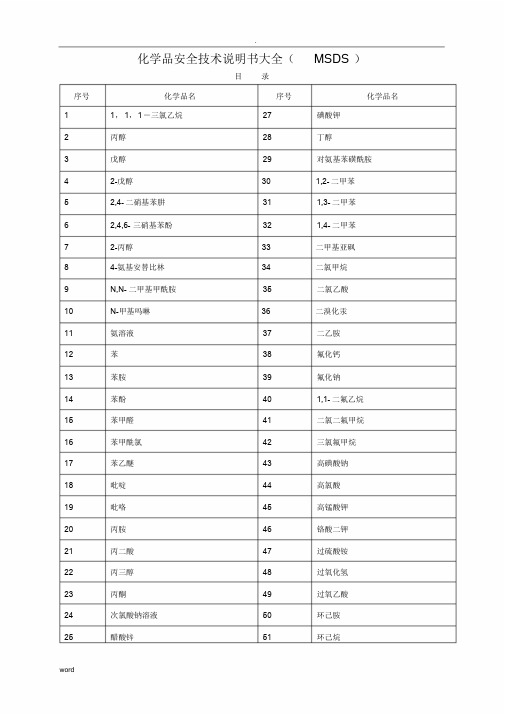
化学品安全技术说明书大全(MSDS )目录序号化学品名序号化学品名1 1,1,1-三氯乙烷27 碘酸钾2 丙醇28 丁醇3 戊醇29 对氨基苯磺酰胺4 2-戊醇30 1,2- 二甲苯5 2,4- 二硝基苯肼31 1,3- 二甲苯6 2,4,6- 三硝基苯酚32 1,4- 二甲苯7 2-丙醇33 二甲基亚砜8 4-氨基安替比林34 二氯甲烷9 N,N- 二甲基甲酰胺35 二氯乙酸10 N-甲基吗啉36 二溴化汞11 氨溶液37 二乙胺12 苯38 氟化钙13 苯胺39 氟化钠14 苯酚40 1,1- 二氟乙烷15 苯甲醛41 二氯二氟甲烷16 苯甲酰氯42 三氯氟甲烷17 苯乙醚43 高碘酸钠18 吡啶44 高氯酸19 吡咯45 高锰酸钾20 丙胺46 铬酸二钾21 丙二酸47 过硫酸铵22 丙三醇48 过氧化氢23 丙酮49 过氧乙酸24 次氯酸钠溶液50 环己胺25 醋酸锌51 环己烷26 碘52 环氧乙烷序号化学品名序号化学品名53 己烷79 氯甲酸异丁酯54 甲苯80 氯酸钾55 甲醇81 氯乙酸56 甲醛82 钼酸铵57 甲酸83 脲58 甲酸甲酯84 硼氢化钠59 甲酸乙酯85 硼酸60 间苯三酚86 偏磷酸61 焦磷酸四钠87 汽油62 咔唑88 氢氟酸63 呋喃甲醛89 氢氧化钙64 连二亚硫酸钠90 氢氧化钾65 磷酸91 氢氧化钠66 磷酸二氢钠92 三氯化铁67 磷酸钠93 三氯甲烷68 硫化钠94 铁氰化钾69 硫酸95 戊醇70 硫酸钠96 2-戊醇71 氯化铵97 硝酸72 氯化钡98 硝酸汞73 氯化汞99 硝酸钾74 氯化钴100 硝酸镁75 四氯化铅101 硝酸钠76 氯化锌102 硝酸银77 氯化亚砜103 溴酸钾78 氯化亚锡104 亚硫酸氢钠序号化学品名序号化学品名105 亚硝酸钠131 正庚烷106 盐酸132 重铬酸钾107 盐酸羟胺133 N,N′-二甲基乙酰胺108 氧化汞134 四氢呋喃109 氧化亚汞135 石油醚110 氧化铝136 水杨酸甲酯111 渣油137 乙二醛112 乙醇138 二苯醚113 乙二醇139 水合肼114 乙二酸140 甲基异丁基甲酮115 乙腈141 二甲胺116 乙醚142 四氯化碳117 乙醛143 石蜡118 乙炔144 乙醇胺119 乙酸145 三乙胺120 乙酸丁酯146 异辛烷121 乙酸酐147 1,2-二氯乙烷122 乙酸汞148 苯甲醚123 乙酸铅149 水杨醛124 乙酸乙酯150 丙酸酐125 2-丙醇151 己醇126 异丙醚152 柠檬酸三乙酯127 异丁醇153 丙酸128 2-甲基庚烷154 蓖麻油129 正丁烷155 山梨糖醇130 异丁烷156 乳酸序号化学品名序号化学品名157 丙二醇183158 苯甲醇184159 三乙醇胺185160 砷186161 铅187162 锌188163 189164 190165 191166 192167 193168 194169 195170 196171 197172 198173 199174 200175 201176 202177 203178 204179 205180 206181 207182 2081,1,1- 三氯乙烷化学品安全技术说明书第一部分:化学品名称 化学品中文名称: 1,1,1- 三氯乙烷 化学品英文名称: 1,1,1-trichloroethane中文名称 2: 甲基氯仿 英文名称 2: methyl chloroform技术说明书编码: 612 CAS No. : 71-55-6 分子式: C2H3Cl3 分子量: 133.42第二部分:成分 /组成信息 有害物成分 含量 CAS No.1,1,1- 三氯乙烷 ≥95.0% 71-55-6 第三部分:危险性概述 危险性类别:侵入途径:健康危害: 急性中毒主要损害中枢神经系统。
- 1、下载文档前请自行甄别文档内容的完整性,平台不提供额外的编辑、内容补充、找答案等附加服务。
- 2、"仅部分预览"的文档,不可在线预览部分如存在完整性等问题,可反馈申请退款(可完整预览的文档不适用该条件!)。
- 3、如文档侵犯您的权益,请联系客服反馈,我们会尽快为您处理(人工客服工作时间:9:00-18:30)。
SAFETY DATA SHEETSAccording to Globally Harmonized System of Classification andLabelling of Chemicals (GHS) - Sixth revised edition1.Identification1.1GHS Product identifierProduct name cobalt,chloride1.2Other means of identificationProduct number-Other names Cobalt monochloride1.3Recommended use of the chemical and restrictions on useIdentified uses For industry use only.Uses advised against no data available1.4Supplier's detailsCompanyAddressTelephoneFax1.5Emergency phone numberEmergency phone numberService hours Monday to Friday, 9am-5pm (Standard time zone: UTC/GMThours).2.1Classification of the substance or mixtureno data available2.2GHS label elements, including precautionary statementsPictogram(s)no data availableSignal word no data availableHazard statement(s)no data availablePrecautionarystatement(s)Prevention no data availableResponse no data availableStorage no data availableDisposal no data available2.3Other hazards which do not result in classificationno data available3.1Substances4.1Description of necessary first-aid measuresGeneral adviceConsult a physician. Show this safety data sheet to the doctor in attendance.If inhaledIf breathed in, move person into fresh air. If not breathing, give artificial respiration. Consult a physician.In case of skin contactWash off with soap and plenty of water. Consult a physician.In case of eye contactRinse thoroughly with plenty of water for at least 15 minutes and consult a physician.If swallowedNever give anything by mouth to an unconscious person. Rinse mouth with water. Consult aphysician.4.2Most important symptoms/effects, acute and delayedno data available4.3Indication of immediate medical attention and special treatment needed, if necessaryno data available5.1Extinguishing mediaSuitable extinguishing mediaUse water spray, alcohol-resistant foam, dry chemical or carbon dioxide.5.2Specific hazards arising from the chemicalno data available5.3Special protective actions for fire-fightersWear self-contained breathing apparatus for firefighting if necessary.6.1Personal precautions, protective equipment and emergency proceduresUse personal protective equipment. Avoid dust formation. Avoid breathing vapours, mist or gas.Ensure adequate ventilation. Evacuate personnel to safe areas. Avoid breathing dust. Forpersonal protection see section 8.6.2Environmental precautionsPrevent further leakage or spillage if safe to do so. Do not let product enter drains. Dischargeinto the environment must be avoided.6.3Methods and materials for containment and cleaning upPick up and arrange disposal. Sweep up and shovel. Keep in suitable, closed containers fordisposal.7.1Precautions for safe handlingAvoid contact with skin and eyes. Avoid formation of dust and aerosols. Avoid exposure -obtain special instructions before use.Provide appropriate exhaust ventilation at places wheredust is formed. For precautions see section 2.2.7.2Conditions for safe storage, including any incompatibilitiesStore in cool place. Keep container tightly closed in a dry and well-ventilated place.8.1Control parametersOccupational Exposure limit valuesno data availableBiological limit valuesno data available8.2Appropriate engineering controlsHandle in accordance with good industrial hygiene and safety practice. Wash hands beforebreaks and at the end of workday.8.3Individual protection measures, such as personal protectiveequipment (PPE)Eye/face protectionSafety glasses with side-shields conforming to EN166. Use equipment for eye protection testedand approved under appropriate government standards such as NIOSH (US) or EN 166(EU).Skin protectionWear impervious clothing. The type of protective equipment must be selected according to theconcentration and amount of the dangerous substance at the specific workplace. Handle withgloves. Gloves must be inspected prior to use. Use proper glove removal technique(withouttouching glove's outer surface) to avoid skin contact with this product. Dispose of contaminatedgloves after use in accordance with applicable laws and good laboratory practices. Wash anddry hands. The selected protective gloves have to satisfy the specifications of EU Directive89/686/EEC and the standard EN 374 derived from it.Respiratory protectionWear dust mask when handling large quantities.Thermal hazardsno data availablePhysical state no data availableColour no data availableOdour no data availableMelting point/ freezingno data availablepointno data availableBoiling point or initialboiling point and boilingrangeFlammability no data availableno data availableLower and upper explosionlimit / flammabilitylimitFlash point no data availableno data availableAuto-ignitiontemperatureDecompositionno data availabletemperaturepH no data availableKinematic viscosity no data availableSolubility no data available Partition coefficientno data availablen-octanol/water (logvalue)Vapour pressure no data availableno data available Density and/or relativedensityRelative vapour density no data available Particle characteristics n o data available10.1Reactivityno data available10.2Chemical stabilityStable under recommended storage conditions.10.3Possibility of hazardous reactionsno data available10.4Conditions to avoidno data available10.5Incompatible materialsno data available10.6Hazardous decomposition productsno data availableAcute toxicity•Oral: no data available•Inhalation: no data available•Dermal: no data availableSkin corrosion/irritationno data availableSerious eye damage/irritationno data availableRespiratory or skin sensitizationno data availableGerm cell mutagenicityno data availableCarcinogenicityno data availableReproductive toxicityno data availableSTOT-single exposureno data availableSTOT-repeated exposureno data availableAspiration hazardno data available12.1Toxicity•Toxicity to fish: no data available•Toxicity to daphnia and other aquatic invertebrates: no data available•Toxicity to algae: no data available•Toxicity to microorganisms: no data available12.2Persistence and degradabilityno data available12.3Bioaccumulative potentialno data available12.4Mobility in soilno data available12.5Other adverse effectsno data available13.1Disposal methodsProductThe material can be disposed of by removal to a licensed chemical destruction plant or bycontrolled incineration with flue gas scrubbing. Do not contaminate water, foodstuffs, feed or seed by storage or disposal. Do not discharge to sewer systems.Contaminated packagingContainers can be triply rinsed (or equivalent) and offered for recycling or reconditioning.Alternatively, the packaging can be punctured to make it unusable for other purposes and thenbe disposed of in a sanitary landfill. Controlled incineration with flue gas scrubbing is possiblefor combustible packaging materials.14.1UN NumberADR/RID: no data available IMDG: no data available IATA: no data available 14.2UN Proper Shipping NameADR/RID: no data availableIMDG: no data availableIATA: no data available14.3Transport hazard class(es)ADR/RID: no data available IMDG: no data available IATA: no data available 14.4Packing group, if applicableADR/RID: no data available IMDG: no data available IATA: no data available 14.5Environmental hazardsADR/RID: no IMDG: no IATA: no14.6Special precautions for userno data available14.7Transport in bulk according to Annex II of MARPOL 73/78 andthe IBC Codeno data available15.1Safety, health and environmental regulations specific for theproduct in questionInformation on revisionCreation Date Aug 16, 2017Revision Date Aug 16, 2017Abbreviations and acronyms•CAS: Chemical Abstracts Service•ADR: European Agreement concerning the International Carriage of Dangerous Goods by Road •RID: Regulation concerning the International Carriage of Dangerous Goods by Rail •IMDG: International Maritime Dangerous Goods•IATA: International Air Transportation Association•TWA: Time Weighted Average•STEL: Short term exposure limit•LC50: Lethal Concentration 50%•LD50: Lethal Dose 50%•EC50: Effective Concentration 50%Disclaimer: The above information is believed to be correct but does not purport to be all inclusive and shall be used only as a guide. The information in this document is based on the present state of our knowledge and is applicable to the product with regard to appropriate safety precautions. It does not represent any guarantee of the properties of the product. We as supplier shall not be held liable for any damage resulting from handling or from contact with the above product.。
